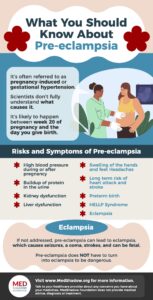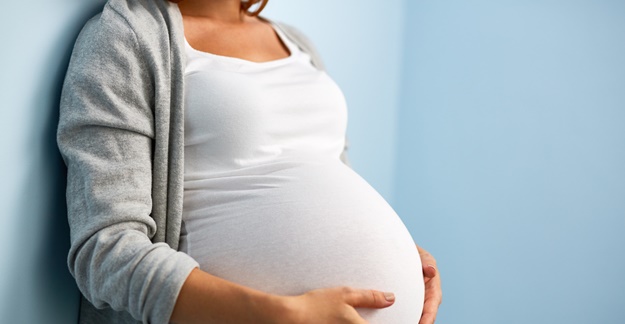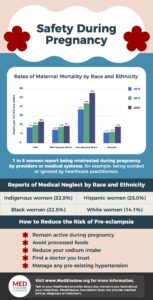When Ghanima Abdullah was pregnant, her legs and feet were so swollen she went to the emergency room. She’d been experiencing added stress because her husband had recently lost his job, so the nurse at the ER monitored her blood pressure. When it dropped to a safe level, she was deemed healthy and was allowed to go home.
But shortly after she gave birth, the dangerously high blood pressure associated with pregnancy, caused by preeclampsia, returned. And it was worse this time.
“I couldn’t breathe. I remember leaning on the walls in the shower and feeling like I needed oxygen,” she says.
Sandee Booth had preeclampsia in 2021. Her symptoms included sudden swelling, severe headaches, fatigue, and vision changes.
Lindsey de los Santos’s blood pressure shot up right after she delivered her son via an emergency C-section. De los Santos has had migraines for years, but at this moment she was experiencing a particularly severe one along with preeclampsia, that kept her in the hospital longer than her newborn.
Julie Palmieri hadn’t noticed any symptoms at all, but at her 38-week appointment, her blood pressure was dangerously high, 180/100. To protect her life, she had to deliver immediately. She’d previously decided to try and avoid medicines and painkillers during labor. “It was challenging,” she said, and she was told to keep her movement to a minimum. After she delivered, she experienced severe bleeding, a complication due to preeclampsia, and had to have a D&C (dilation and curettage) to remove bleeding tissue from the uterus.
Whether you experience no symptoms or struggle to breath, preeclampsia is a serious condition that occurs during and after pregnancy. And it’s not only dangerous in the moment, but can put both you and your fetus at risk. It can also raise your chances of developing other conditions, like heart attacks and strokes, for the next 20 years. Here’s what you need to know about this serious condition.
What is Preeclampsia?

“Pre-eclampsia is often referred to now as pregnancy-induced hypertension, or gestational hypertension,” says Nelson Adams, MD an OBGYN who is focused on eliminating disparities in health. Its most consistent symptom is high blood pressure that happens during or after your pregnancy. It’s also often characterized by a buildup of protein in the urine, which suggests that your kidneys aren’t functioning properly. Pre-eclampsia can cause changes in your liver function and blood clotting ability.
Pre-eclampsia can be classified as mild, moderate or severe, based on your blood pressure measurements, explains Adams.
If not addressed, preeclampsia can lead to eclampsia, which causes seizures. Those seizures may leave you in a coma. You can also have strokes. The condition can be fatal.
It’s not always easy to identify the difference, but it is also possible to have hypertension, or high blood pressure, during pregnancy and not have preeclampsia.
Scientists don’t fully understand what causes preeclampsia, but they suspect it could be related to insufficient blood flow to the placenta, hormonal changes, environmental exposures, cardiac conditions or autoimmune conditions.
Preeclampsia’s Effect on the Baby
If you develop preeclampsia, you may need to deliver your baby preterm, and he or she may have a low birth weight.
In those that do not have preeclampsia, three out of every thousand births is a stillbirth. If you have mild preeclampsia, that risk increases to nine out of a thousand. If your preeclampsia is severe, that number jumps to 21 out of 1,000 births.
Pre-eclampsia can make it harder for the fetus to get enough oxygen and nutrients, which may restrict their growth in your uterus. These infants are more likely to face long term health conditions such as learning disabilities, cerebral palsy, epilepsy, diabetes, congestive heart failure, high blood pressure, deafness and blindness, according to the National Institutes of Health (NIH).
Can Preeclampsia Happen After You Give Birth?
Pre-eclampsia is most likely to happen between week 20 of your pregnancy and the day you give birth, but it can occur up to about 6 weeks after you’ve delivered your baby. This is called postpartum preeclampsia, and just like preeclampsia during pregnancy, it requires prompt medical attention.
For Becky Morrison, a nurse practitioner, preeclampsia started just 30 minutes after she gave birth to her son via cesarean section.
“In recovery, my blood pressure started to rise quickly and continued to rise even after being put on three antihypertensives. I started to feel nauseated and then started to rigor [experience a cold sweat, often associated with fevers] which continued for four weeks,” she says. “As my pressure went up, my renal and liver function declined, and I had this sense of peace. No headache. No pain. No change in vision. Just peace. Soon after that, I was in the ICU for two days until my blood pressure normalized and my liver and kidney function returned to normal.”
Pregnancy and COVID
All infections become riskier if you’re pregnant. Your body is diverting some of your own important resources to help the fetus grow, making you more vulnerable to other conditions or complications.
Pregnancy also alters your immune system. You’re more prone to swelling during pregnancy as you’re carrying extra water and blood may have a more difficult time moving through your body with a fetus in the way. That swelling isn’t exclusive to your legs and feet, in some cases, it can mean swelling in your airways that makes it difficult to breathe, for example. That puts your fetus at risk as well. If you can’t get enough oxygen, neither can the fetus.
Having moderate to severe COVID-19, which is known to cause blood clots and other vascular problems in some cases, while pregnant during the first two years of the pandemic raised a woman’s risk of preeclampsia before week 34 eight-fold. The study only tracked up to February 2022. These rates may have changed as more people got vaccinated and as new variants such as Omicron took hold.
Maternal Mortality Rates, Country, and Race
In mid-March 2023, The National Center for Health Statistics released a report showing that maternal deaths—deaths that occurred during pregnancy or within 42 days of ending the pregnancy—are on the rise. In 2019, the maternal mortality rate was 20.1 out of every 100,000 live births. In 2020 it was 23.8 and in 2021 it was 32.9.
Much of that increase may be a result of the pandemic, but the U.S. was seeing poor healthcare outcomes for mothers long before COVID-19.
Women of color, in particular Black women, tend to fare the worst.
Rates of preeclampsia are also higher for women of color than they are for white women. A 2021 study, found that the rates of preeclampsia among Black, Hispanic, and white women were 12.4%, 8.2% and 7.1%, respectively.
While there may be a genetic component (Black individuals are more likely to have a heritable sensitivity to salt that leads to high blood pressure than people of other ethnicities.) That study found that Black women born in the U.S. had a higher risk of preeclampsia than Black women born outside of the U.S., suggesting that ethnicity on its own cannot explain the risk.
Another reason for maternal deaths is disparities in access to affordable care, which means that some women are less likely to have reliable medical care throughout their pregnancies, particularly in some parts of the country where labor and delivery hospital units are closing. Lastly, one in six women (17.3%) reported being mistreated during pregnancy by providers or medical systems, for example, being scolded or ignored by healthcare practitioners. Indigenous women were the most likely to say they experienced mistreatment (32.8%) followed by Hispanic (25.0%) and Black women (22.5%) and white women (14.1%).
Stillbirths and Race
The rate of stillbirths has declined dramatically since the 1940s, but that decline seems to have almost halted within the last 15-20 years, according to the CDC. The rate has been hovering just below six per 1,000 births since 2005.
But the rate is not equal among fetuses of different races. Native Hawaiians, Pacific Islanders, and Black fetuses experienced stillbirths in more than 10 out of every 1,000 births in 2020. The rates are as follows: white women: 4.73, Black women: 10.34, American Indian or Alaskan Native: 7.84, Asian: 3.93, Native Hawaiian or Pacific Islander: 10.59, and Hispanic: 4.86.
Symptoms of Preeclampsia
As demonstrated at the start of this article, symptoms of preeclampsia can vary widely. You may not notice anything out of the ordinary, or you could mistake your swollen legs and feet as being a typical symptom of pregnancy. That’s why it’s so important to make sure you have a healthcare provider you trust as early as possible, ideally before you’re even pregnant!
“Sometimes you don’t know when it’s happening. So you ask your doctor if you’re getting headaches, if you’re getting pains,” says Lanise Washington, a doula in Chicago. You can also purchase a blood pressure monitor to use at home to monitor levels frequently.
Symptoms of preeclampsia can include:
- Swelling of the hands and feet
- Headaches, especially ones that don’t respond to Tylenol (acetaminophen) [Editor’s note: Some scientists are pushing back against using Tylenol during pregnancy as studies find it may raise the risk of ADHD and other disorders in the children, but it’s still considered safer than ibuprofen, and the conditions it treats, like fevers and sever headaches, may also be dangerous for the baby. Read more about evaluating medications in pregnancy in MedShadow’s Can I Take This Drug While Pregnant?]
- Visual disturbances, such as seeing flashing lights
Risk Factors for Pre-Eclampsia
Many women who develop preeclampsia don’t have any known risk factors, but there are still things you can do to reduce your risk. The same lifestyle habits that help prevent high blood pressure when you’re not pregnant apply when you are. That means you should be exercising regularly before pregnancy and adapting as necessary to stay active throughout your pregnancy.
Maintain a healthy diet, avoiding heavily processed foods, particularly those that are high in sodium, explains Adams.
Washington adds that many pregnant women might not realize how important their diet is. For example, even if you don’t drink milk regularly, you need to find a way to get calcium and vitamin D. One option is eating yogurt.
As mentioned above, Black individuals are more likely to have a heritable sensitivity to salt that leads to high blood pressure than people of other ethnicities, so it’s especially important for this group to monitor salt intake.
Download MedShadow’s Dining Out on a Low Sodium Diet Guide so you can keep both your diet and your social life.
Preventing Pre-Eclampsia
Some of the best ways to lower your risk of developing preeclampsia include:
- Reducing Stress
- Eating a low-sodium diet
- Managing any existing hypertension
- Finding a healthcare provider you trust and getting regular care
“Finding [a doctor] that you can relate to is not always that easy,” says Adams. If you can, “shop around” before you become pregnant. Consider asking friends and family for OB/GYNs that they trust and recommend.
Washington says that a lot of first-time mothers “are scared to go to the doctor. They weren’t brought up going to the doctor or [with] regular doctor visits.”
Adams adds that “you can’t really separate medical care, the healthcare, if you will, from the social environment, so many of the stressors come from the environment.”
A doula can help guide you through the pregnancy process and may help assuage your stress.
“When we start with a young lady, we do a birth plan and to let the doctors know what they will want during their labor and delivery, and we make a copy of it so she can give it to her doctor, and they can have it there at the hospital. We help them to have a voice in the hospital,” Washington explains.
Washington makes sure her clients visit the doctor regularly. She also tells them that they need to ask at least three questions at every visit. Some of those questions might be, “How does it feel when your labor is starting? What should I be looking for to know when I’m in labor? What are the side effects from anything that I’m taking?”
Treatments for Pre-Eclampsia
Delivering the Baby
“We don’t exactly know all of the mechanisms, but we know preeclampsia is pregnancy-related and because of that, when the pregnancy ends, generally speaking, the hormones and the other changes that have taken place begin to wane. and As they wane, the likelihood of the blood pressure staying elevated decreases, and patients usually fairly quickly return to baseline,” says Adams
Magnesium Drip
In the hospital, you may be put on an IV treatment called a magnesium drip.
“Though it does often result in the blood pressure being lowered, it is really for neuroprotection—to protect the mother and the baby neurologically,” says Adams. The drug helps prevent seizures, and you’ll usually stay on it throughout labor.
De los Santos was given magnesium when she experienced postpartum preeclampsia.
“Within 24 hours my blood pressure was regulated and my migraine was decreasing,” she says. “It brought me back. You are only allowed to drink a certain amount of water while on this treatment, and it can make you feel hot.”
The magnesium drip can cause:
- Muscle weakness
- Confusion
- Irregular heart rates
- Drops in blood pressure that makes you feel dizzy, lightheaded or blurs your vision
- Difficulty breathing
- Redness and sweating
- Headache
- Nausea
You will be monitored in the hospital while you’re on the magnesium drip. Make sure you’re telling your medical team about any side effects you’re feeling so you can decide together whether to lower the dose or stop the medicine and deliver your baby.
Antihypertensives
If you have severe hypertension (blood pressure of 160 systolic blood pressure or diastolic of 110 higher) your doctor may recommend one of the following three hypertensive medications, which are considered the frontline therapies for preeclampsia with severe hypertension. These drugs likely cross the placenta, meaning they can affect your fetus, but do not accumulate there, so the exposure is limited, an analysis of 30 studies found.
The three drugs are labetalol, nifedipine, and methyldopa.
Side Efects of Labetalol:
Some of the more dangerous side effects of labetalol can look like the worsening preeclampsia.
They can include:
- Severe headaches
- Lightheadedness
- Low blood pressure
- Slowed heart rate
- Blurred vision
- Shortness of breath
- Chills
- Chest tightening
Some of the more common, and less serious, side effects of labetalol include:
- Dizziness and drowsiness
- Nausea
- Numbness and tingling, especially in the scalp
- Warm, red skin
Side Effects of Nifedipine
More serious side effects of nifedipine include:
- Swelling
- Bloating
- Coughing
- Fast, irregular heart rate
- Cramps
- Shakiness
- Shortness of breath
- Tingling, trembling or weakness
Some of the more common, less serious, side effects of nifedipine include:
- Belching
- Flushed skin
- Mood changes
- Indigestion
Side Effects of Methyldopa
More serious side effects of methyldopa include:
- Lightheadedness
- Shortness of breath
- Swelling
- Involuntary muscle movements
- Nausea, loss of appetite, stomach pain
- Increased heart rate
- Yellowed skin
- Dark urine
- Increased heart rate
More common, less serious, side effects include:
- Headache
- Drowsiness
- weakness
It’s important to note that these drugs do not prevent eclampsia or seizures.
Complications and Long-Term Risks After Pre-Eclampsia
“Pre-eclampsia is nothing to play with,” says Washington. “If you are diagnosed with preeclampsia, you need to follow thedoctor’s instructions. That is a must. There’s no getting around it; you have to follow the doctor’s instructions because it can lead to death. If you have complications after getting diagnosed, you need to get to the hospital no matter what.”
Preeclampsia doesn’t have to turn into eclampsia in order to be dangerous. Adams explains that some women develop HELLP syndrome (hemolysis, elevated liver enzymes, and low platelets). Platelets help your blood clot to prevent you from bleeding too much. When you don’t have enough of them in your blood, you’re at risk for losing too much blood, especially during childbirth.
Like with preeclampsia, the main treatment for HELLP syndrome is delivering your baby, but you may also be given corticosteroids or a blood transfusion while you give birth. The use of corticosteroids, like dexamethasone, in treating HELLP is controversial. Research has shown conflicting results regarding whether or not the treatment actually reduces the risk of maternal or infant death. Make sure you discuss this option—and any other potential treatment decisions—with your doctor early in your pregnancy so you’re not trying to understand the risks and benefits to make decisions during a stressful, painful and urgent situation.
However, if you’re at risk of delivering preterm—as is often the case with preeclampsia—corticosteroids may help improve your baby’s lung development and reduce other risks of being born preterm if you’re given a course of the drugs about a week or so before delivery. The drugs can cause changes in the fetus’s heart rate on days two and three after you’ve started taking the drugs, but they typically return to normal within four to seven days. Mothers may experience an increase in blood sugar and need to be monitored for gestational diabetes.
Additionally, women who experienced preeclampsia during pregnancy are more likely than other women to experience a heart attack or stroke within the next 20 years, so it’s extra important to take steps to manage your blood pressure even after you give birth.
In the 2023 study, 1.2% of women without preeclampsia had a stroke or heart attack in the 20 years after having given birth, compared to 2.0% percent of the women who did experience preeclampsia. The relative risk was highest (three- to four-fold higher than women without preeclampsia) in the first decade years after giving birth, but did still remain elevated 20 years later.
To read more about the side effects of corticosteroids on the general population, see:
Prednisone: The Steroid That Can Cause Mood Swings
Resources:
To Find a Doula
https://everymothercounts.org/choicesinchildbirth/resources/more-resources-about-doulas/
To Find a Culturally Competent Doctors
https://blackdoctor.org/find-a-doctor/
To Manage High Blood Pressure
Ways to Lower Blood Pressure Without Drugs
Heart Disease Prevention, Treatment and Side Effects
Stress Need Not Be Your Constant Companion
Can Forest Bathing Keep You Healthy?







